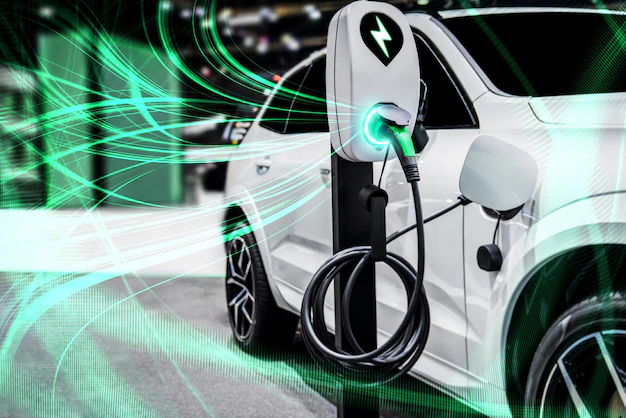Table Of Contents
- The Emergence of Electric Vehicles as a Solution
- Understanding EV Charging Infrastructure
- Types of EV Charging Stations
- Challenges in EV Charging Infrastructure
- EV Charging's Role in Reducing Urban Air Pollution
- The Economic and Social Benefits of EV Charging Networks
- The Future of Urban Transportation and EV Charging
- For Cleaner Air and Sustainable Cities
The Role Of EV Charging In Reducing Urban Air Pollution
Last Updated on: September 25th, 2025
Urban areas worldwide are grappling with a growing menace: air pollution. This silent killer, originating from various sources like industrial emissions, vehicular exhaust, and energy production, significantly impacts public health and the environment.
In many cities, air quality often breaches the safe limits set by health organizations, leading to a rise in respiratory diseases, cardiovascular problems, and environmental degradation. The need for sustainable and clean alternatives in urban transportation has never been more pressing.
The Emergence of Electric Vehicles as a Solution
Electric vehicles (EVs) have emerged as a beacon of hope in the quest for cleaner air. Their rising popularity is not just a trend but a crucial step toward reducing the reliance on fossil fuels.
Unlike traditional vehicles with internal combustion engines, EVs produce zero tailpipe emissions, making them a greener alternative. Governments worldwide, including the UK, acknowledge this potential by introducing incentives and policies to accelerate EV adoption.
What Are The Benefits Of The Electric Vehicles
The EVs have benefits galore, which is why people develop a liking for these vehicles. The electric vehicle manufacturers, too, are trying their best to bring in technological improvements. They work persistently on these EVs, which is why the acceptability of this technology is on the higher levels. However, let us try to understand its benefits against that of general vehicles.
Lower Running Cost
The cost of petroleum products like gasoline is depleting. It is becoming a matter of concern. People are becoming aware of the development. This is why there has been a thorough increase in the number of EVs.
Pollution Levels
The world is now aware of the insensible burning of greenhouse gases, culminating in global warming. The fossil fuels are a great source of pollution. It increases with time. This is where the role of the EVs becomes highly important. The EVs have low emissions. It syncs with the country’s policy of Net Zero emissions.
Petrol And Diesel Destroy Our Planet
The toxic emissions have adverse effects on the planet. They have a long-term and adverse effect on public health. The impact of emissions on EVs is much lower compared to petrol cars. They are also superior from the point of view of efficiency. The EVs cover around 60% of the electric energy. On the other hand, petrol and diesel cars can convert only upto around 17% to 21% of their power.
Understanding EV Charging Infrastructure
At the heart of the EV revolution is the need for robust and accessible EV charging infrastructure. The concept of EV charging is straightforward: electric cars, like any electronic device, require charging. However, the landscape of EV charging infrastructure, especially in the UK, is evolving rapidly. Companies like Blink Charging are at the forefront of this transformation, working to make EV charging more accessible and efficient.
Types of EV Charging Stations
There are primarily three types of EV charging stations: Level 1 (slow, often used for home charging), Level 2 (faster, used both at home and in public spaces), and DC Fast Chargers (the quickest, suitable for public charging stations).
- Level 1 chargers are the most basic and accessible type of EV charging station. They typically use a standard 120-volt AC plug primarily intended for home use. Although they are the slowest in charging speed, offering around 2 to 5 miles of range per hour of charging, they are suitable for overnight charging or EV users with minimal daily driving distances.
- Level 2 chargers are faster than Level 1 chargers and are commonly found in public and private settings, including residential, commercial, and workplace environments. These chargers typically require a 240-volt AC plug (similar to large appliances like dryers) and can provide about 10 to 60 miles of range per hour of charging. Level 2 chargers are ideal for daily use and are commonly installed in homes for overnight charging.
- DC fast chargers, or Level 3 chargers, are the quickest EV charging stations available. They are typically found along highways or in areas where drivers need to recharge while on longer trips. Depending on the vehicle and the charger’s capacity, DCFC stations can charge an EV battery to 80% in as little as 20 to 30 minutes. However, frequent fast charging can reduce the battery’s lifespan over time due to the high power output.
Each type of EV charging station offers different benefits and is suited to different user needs and scenarios. Choosing a suitable charger depends on factors like the specific EV model, the driver’s daily mileage, the availability of charging stations, and the time available for charging.
Challenges in EV Charging Infrastructure
Despite the advancements, there are challenges in the widespread deployment of EV charging stations. These include the need for significant investment in grid infrastructure and overcoming logistical hurdles in densely populated urban areas.
However, solutions are emerging, with companies like Blink Charging innovating and collaborating with governments and other stakeholders to create a more connected and efficient charging network.

EV Charging’s Role in Reducing Urban Air Pollution
EV charging stations directly reduce urban air pollution by supporting the operation of electric vehicles, which emit no pollutants. Studies have shown that a rise in EV usage correlates with a noticeable improvement in urban air quality. As more people switch to electric vehicles, aided by the expansion of charging infrastructure by companies like Blink Charging, the positive impact on urban air quality is expected to grow exponentially.
The Economic and Social Benefits of EV Charging Networks
Beyond environmental benefits, expanding EV charging networks brings economic and social advantages. They create new jobs in manufacturing, installing, and maintaining charging stations, drive investment in clean energy technologies, and offer consumers cost-effective alternatives to petrol or diesel vehicles. These developments contribute to healthier communities by curbing air pollution-related health issues.
The Future of Urban Transportation and EV Charging
The future of urban transportation is inextricably linked with the growth of the EV market and its supporting infrastructure. Trends suggest a move towards more integrated, intelligent charging solutions and, potentially, autonomous electric vehicles.
For Cleaner Air and Sustainable Cities
The shift to electric vehicles, supported by companies like Blink Charging, represents a significant leap towards cleaner, healthier urban environments.
As individuals, embracing EVs and supporting the expansion of EV charging infrastructure is a step we can all take toward sustainable urban living. By doing so, we contribute to reducing air pollution and shaping the future of urban transportation for the better.
Read Also:















